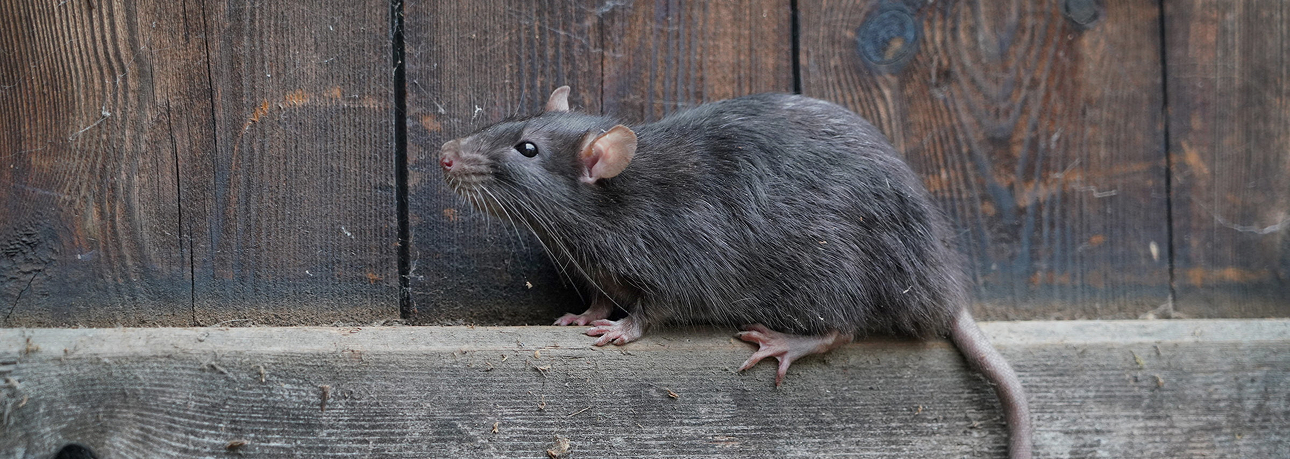Rodent Removal Service
Rats and Mice
Various species of rats and mice inhabit the Orange County area, but the primary focus for addressing a rodent infestation lies in distinguishing between rats and mice. Although multiple species exist within each category, the control methods remain consistent. Our attention here will center on the most common types observed in Orange County: the roof rat and the house mouse

Roof Rat
Identification
Color
Dark brown to black, sometimes Grey with a lighter underbelly.
size
Adults are about 6-8 inches in length excluding their tails.
tail
Adults have tails longer than their bodies, ranging between 7-10 inches in length.
dropping
Black, approximately ½” in length, with pointed ends, often curved.
Habitat
Roof rats are urban dwellers, favoring paths of travel and nesting areas that are raised off the ground. Trees, vine covered fences, attic spaces, and walls are all places roof rats are happy to call home with nesting sites often set up in secluded areas indoors using a number of different nesting materials such as shredded paper, vegetation, cloth, and insulation.
Behavior
Roof rats are nocturnal and very good climbers, traveling about 100-300 feet from wherever they are nested to explore and scavenge for food. They can fit into any opening ½” of greater in diameter, or about the size of a quarter. Their incisor teeth are continuously growing, which motivates them to consistently chew and gnaw on a variety of objects/materials.
Preferred Food Choices
Roof rats are omnivorous, meaning they eat both plants and animals. Some common food choices are fruits, grains, seeds, nuts, insects, small animals, dog food, grease, etc. They also require about 1fl oz of water each day when feeding on dry foods.
Reproduction
Once a female roof rat reaches sexual maturity at about 3-5 months in age, it is capable of having multiple litters each year with each litter consisting of 5-8 offspring. The lifespan of a roof rat is about one year.
In theory, a roof rat population is potentially capable of swelling to over 1,000 in just one year!
House Mouse
Identification
Color
Light brown to gray with a white underbelly.
size
Adults are about 2-4 inches in length excluding their tails.
tail
Adult tails are about the same as their body length, approximately 2-4 inches in length.
dropping
Adult mice droppings are about ⅛”-¼” in length with pointed ends.
Habitat
The house mouse prefers to dwell indoors. They will create nests in secluded areas such as wall voids, attics, basements, and behind appliances, using materials like shredded paper, fabric, and insulation.
Behavior
Primarily nocturnal, house mice scavenge mostly at night when there is less human activity. Like rats, their incisor teeth are continuously growing, which motivates them to consistently chew and gnaw on a variety of objects/materials. House mice only travel about 10-50 feet away from their nesting site, often darting from cover to cover in order to avoid detection.
Preferred Food Choices
House mice are opportunistic feeders with a varied diet, consuming grains, seeds, nuts, fruits, vegetables, insects, and small amounts of protein.
Preferred Food Choices
House mice are opportunistic feeders with a varied diet, consuming grains, seeds, nuts, fruits, vegetables, insects, and small amounts
Reproduction
Once a female house mouse reaches sexual maturity at 1-2 months, they are capable of having 5 to10 litters annually, with each litter containing 5-6 offspring. The lifespan of a house mouse is about 9-12 months. and insulation.
In theory, a pair of house mice could produce 5,000 offspring in a single year!
Reproduction
Once a female house mouse reaches sexual maturity at 1-2 months, they are capable of having 5 to10 litters annually, with each litter containing 5-6 offspring. The lifespan of a house mouse is about 9-12 months.
In theory, a pair of house mice could produce 5,000 offspring in a single year!
Step 1
Eliminate exterior to interior access
Remember, roof rats only need an opening ½” in diameter and a mouse only needs an opening ¼” in diameter. So, all potential entry points should be sealed to at least ¼” on smaller. Common potential entry points include gaps or openings around doors, windows, garage doors, utility pipes, wires, plumbing, HVAC lines, roofing lines, eaves, holes in exterior walls, weep screeds, etc.
Once all potential entry points have been identified, they need to be properly sealed with materials that will stand up to both the rodents themselves and weathering. Materials to be used might include steel wire mesh, silicone, cement, stucco, steel wool, expanding foam, weather stripping, or pipe plugs.
What does this accomplish? When all potential entry points are identified and sealed, there are two outcomes. First, rodents that are exterior of the structure at the time of sealing cannot enter back into the home. Second, rodents that are on the interior of the structure at the time of sealing have been cut off from their food sources that exist outside of the structure. Which leads us into Step 2…

Step 2
Eliminate controllable food sources
Any potential rodent food source must be properly stored. Some examples of proper food storage include using airtight containers, placing all food within cupboards and refrigerators that close tightly and are elevated from the floor, and removing food residual in and around the structure. Pet food should be stored in an airtight container and pets should be fed on a schedule as to not leave accessible food exposed throughout the day or night.

Step 3
trapping
Once steps 1 and 2 have been completed, an ideal trapping environment has been created. Rodents that are within the structure now have no access to food or water, forcing them to go for the only food available to them. The bait in the traps.

Step 4
Monitor and Inspect
Rodents are smart, often doing things to survive you might not expect. Monitoring all of the aspects listed in steps 1-3 is crucial to the success of the rodent proofing program. This ensures that entry points remain to be sealed, food sources remain to be limited, and traps continue to be placed in the most optimal locations.
For professional help reach out:

Residential
We offer a variety of plans custom fit for your needs! Whether its an endless trail of ants, or strange noises in the walls, we’ve got your pest control needs covered!

Commercial
We can stop pests from causing costly machinery repairs, fines, closures, and damage to your reputation!

rodents
Various species of rats and mice inhabit the Orange County area. Remove rodents from your home permanently with our exclusion services.

mosquito
We use the In2Care system to eliminate mosquitoes where they breed—protecting your family’s health and comfort.

